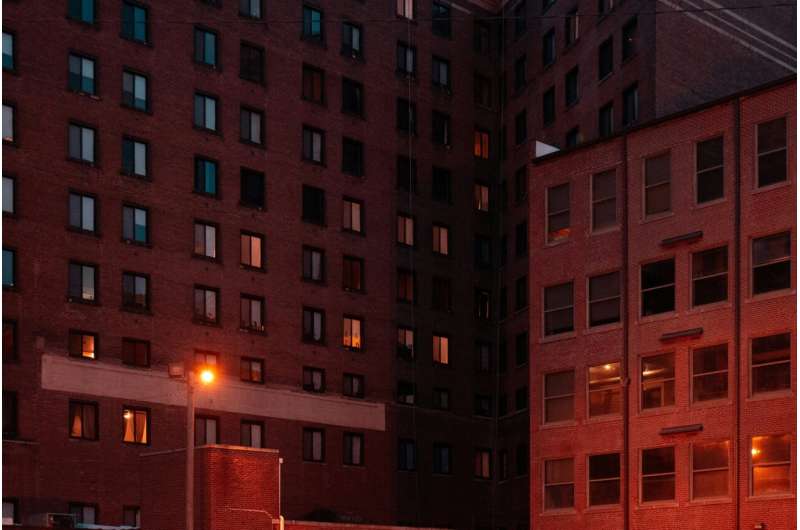This article has been reviewed according to Science X's editorial process and policies. Editors have highlighted the following attributes while ensuring the content's credibility:
fact-checked
peer-reviewed publication
trusted source
proofread
How community stress affects Black Americans' mental health and well-being

Residential segregation is an example of the long history of structural racism in the United States. Black Americans are more likely to live in low-quality neighborhoods, which contributes to disparities in health outcomes. A new study from the University of Illinois Urbana-Champaign looks at how community stress affects the mental and emotional health of Black men and women in the U.S.
"Community stress refers to the effects of living in disadvantaged areas. This includes objective aspects, such as buildings in disrepair and lower median income. There is also a subjective aspect—do I feel safe and comfortable where I am living?
"We were interested in seeing how both aspects are related to mental and emotional health for Black Americans, and whether there are differences for men and women," said lead author August Jenkins, a postdoctoral research associate in the Department of Human Development and Family Studies, part of the College of Agricultural, Consumer and Environmental Sciences (ACES) at Illinois.
Jenkins and her colleagues analyzed data from the Midlife in the United States (MIDUS) study, a longitudinal study of health and aging that includes assessments of psychological and neighborhood factors. They drew on data from MIDUS' third wave, collected in 2013–2015, which included a sample of Black Americans from Milwaukee, Wisconsin.
The study measured objective neighborhood quality with the Area Deprivation Index, which includes rankings based on indicators related to education, employment, income, and housing quality. Perceived Neighborhood Disadvantage captured subjective aspects of community stress with self-reported measures on neighborhood safety, social cohesion, and physical environment.
Mental-emotional health was assessed via three measures: negative affect, positive affect, and psychological disorder. To assess affect, participants rated how frequently in the past 30 days they felt a series of different positive and negative emotions.
As expected, the researchers found that people who reported greater perceived community stress had higher levels of negative emotions and lower levels of positive emotions. In addition, Black women (but not men) had higher odds of psychological disorders. However, they found that greater objective community stress was related to lower levels of negative emotions and lower odds of experiencing clinical disorder, specifically for women.
Explaining the unexpected finding, Jenkins said, "Living in more disadvantaged neighborhoods may elicit greater investment in social connection and networks for Black women. This doesn't mean that disadvantage is good for Black women's mental health. But it could be creating conditions where you rely more on your social networks, and it's those social connections that bring about health benefits."
She noted that it's important to consider the geographical placement of the sample.
"Milwaukee has a very long history of high levels of racial residential segregation, and there is also a high prevalence of Black women being subject to housing eviction. They may be especially attuned to their residential surroundings and living in precarious spaces, which could be a necessary skill for their resilience.
"This may explain the associations between objective neighborhood characteristics and emotional well-being that we observe for Black women but not for Black men."
She also noted that perceived community stress was associated with psychological disorders for Black women, but not for men. However, the negative impacts of perceived community stress on Black men can be seen in terms of their emotionality.
"There's research indicating that depression and anxiety can show up more somatically for Black Americans than traditionally captured in clinical assessment. In this study, we wanted to include measures of positive and negative affect, because if we only look at clinical outcomes, we're not really capturing a full picture of the mental health and functioning for Black men and women," she said.
The research underscores the importance of a holistic perspective that considers the intersection of race and gender to better understand the complex associations between neighborhood quality and well-being, Jenkins noted.
"Our results indicate that investing in social connections and networks in your neighborhood might provide a sense of agency, but we should still recognize this is a structural issue. We can advocate for policy changes to invest in these communities and remediate disadvantages, as well as provide clinical interventions or prevention programs to help improve mental health outcomes for individuals," she concluded.
The paper, "Where I'm Livin' and How I'm Feelin': Associations among community stress, gender, and mental-emotional health among Black Americans," is published in Social Science & Medicine. Authors include August Jenkins, Agus Surachman, and Marina Armendariz.
More information: August I.C. Jenkins et al, Where I'm Livin' and How I'm Feelin': Associations among community stress, gender, and mental-emotional health among Black Americans, Social Science & Medicine (2024). DOI: 10.1016/j.socscimed.2024.116763




















